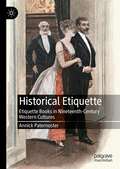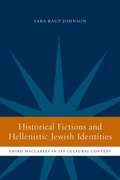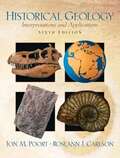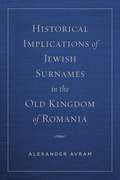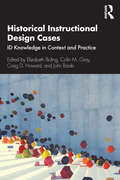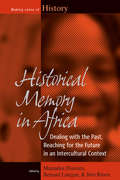- Table View
- List View
Historical Ecology: Learning from the Past to Understand the Present and Forecast the Future of Ecosystems
by Guillaume DecocqThis book addresses present-day landscapes, ecosystem functioning and biodiversity as legacies of the past. It implements an interdisciplinary approach to understand how natural or human-impacted ecological systems have changed over time.Historical Ecology combines theory, methods, regional case studies and syntheses to provide a complete up-to-date overview of historical ecology. Beginning with the crucial role of time and inference from observed patterns, the book critically reviews the main methodological approaches, including monitoring of permanent plots, analysis of old maps, repeat photography, remote sensing, soil analysis, charcoal analysis, botanical indicators, and combinations of these methods applied to forest ecosystems.A series of case studies from various biomes shows how historical ecology can help in understanding today&’s socio-ecosystems, such as mainland and island forests, orchards, tundra and coastal dunes. The book concludes by showing how historical ecology can answer timely fundamental research questions and provide science-based evidence for landscape and ecosystem management.
Historical Etiquette: Etiquette Books in Nineteenth-Century Western Cultures
by Annick PaternosterThis book is a groundbreaking study of etiquette in the nineteenth century when the success of etiquette books reached unprecedented heights in Britain, France, Italy, the Netherlands, and the United States. It positions etiquette as a fully-fledged theoretical concept within the fields of politeness studies and historical pragmatics. After tracing the origin of etiquette back to Spanish court protocol, the analysis takes a novel approach to key aspects of etiquette: its highly coercive and intricate scripts; the liminal rituals of social gatekeeping; the fear for blunders; the obsession with precedence. Interrogating the complex relationship between historical etiquette and adjacent notions of politeness, conduct, morality, convention, and ritual, the study prompts questions on gender stereotyping and class privilege surrounding the present-day etiquette revival. Through adopting a unique comparative approach and a corpus-based methodology this study seeks to revitalise our understandings of etiquette. This book will be of interest to scholars of historical linguistics and pragmatics, as well as those in neighbouring fields such as literary criticism, gender studies and family life, domestic and urban spaces.
Historical Experience: Essays on the Phenomenology of History (Routledge Approaches to History)
by David CarrThis volume brings together a collection of recent essays on the philosophy and theory of history. This is a field of lively interdisciplinary discussion and research, to which historians, philosophers and theorists of culture and literature have contributed. The author is a philosopher by training, and his inspiration comes primarily from the continental-phenomenological tradition. Thus the influence of Husserl, Heidegger, Merleau-Ponty and Ricoeur can be discerned here. This background opens up a unique perspective on the issues under discussion. Phenomenology differs from other philosophical approaches, like metaphysics and epistemology. Phenomenology asks, of anything that exists or may exist: how is it given, how does it enter our experience, what is our experience of it like? Very broadly we can say: phenomenology is about experience. At first glance, this approach may seem ill-suited to history. In our language, “history” usually means either 1) what happened, i.e. past events, or 2) our knowledge of what happened. We can’t experience past events, and whatever knowledge we have of them must come from other sources—memory, testimony, physical traces. But the author maintains that we actually do experience historical events, and these essays explain how this is so. Sitting at the intersection of philosophy and history, and divided into three parts—Historicity, Narrative, and Time, Teleology and History, and Embodiment and Experience—this is the ideal volume for those interested in experience from a philosophical and historical perspective.
Historical Explanation: An Anti-Causalist Approach (Routledge Studies in Contemporary Philosophy)
by Gunnar SchumannThis book is concerned with the appropriate form of explanations in historiography and the social sciences. It combines action theory and philosophy of historiography and develops a theory of teleological explanations of human actions based on late-Wittgensteinian and Ordinary Language Philosophy insights. In philosophy of action, many philosophers favor causal theories of human action. Additionally, in current philosophy of historiography the majority view is that historians should explain historical phenomena by their causes. This book pushes back against these mainstream views by reviving an anti-causal view of explanation of current and past human actions. The author argues that disciplines that deal with human actions require a certain form of explanation, namely a teleological or intentional explanation. This means that past human actions and their results will have to be explained by reasons of agents, not by causes. Therefore, historiography employs a method of explanation which is in stark contrast to the sciences. The author thus proposes a Verstehen (understanding) approach in historiography and the social sciences. Historical Explanation will be of interest to scholars and advanced students working in philosophy of action, philosophy of history, and philosophy of the social sciences.
Historical Explorations of Modern Epidemiology: Patterns, Populations and Pathologies (Medicine and Biomedical Sciences in Modern History)
by Heini Hakosalo Katariina Parhi Annukka SailoThis volume explores the history of epidemiology from the mid-twentieth century to the present. Epidemiology has exerted major influence on the way that both infectious and chronic diseases are conceptualized and controlled, and, more generally, on the way that people in modern societies think about health, behavior, longevity, and risk. This collection consists of a series of in-depth analyses of the roots, development, and impact of epidemiological research, illuminating the complex relationship between medical research and data on the one hand, and social and cultural factors on the other. The thematical and geographical scope of the book ranges from indigenous and participant perspectives to the visualization of pandemics, and from Circumpolar North to East Africa. The book identifies significant historical changes and the driving forces behind them, charting forms of science-society interaction that characterize modern epidemiology. Chapter 1 and chapter 4 are available open access under a Creative Commons Attribution 4.0 International License via link.springer.com.
Historical Fiction Collection, The
by L. Ron HubbardRiveting, historical accounts of daredevils, pilots and brutal madmen that inspire many of today's cinematic blockbusters. Step back in time with these thrilling tales that appeared in the pages of the most popular pulp fiction magazines of the 1930's and 1940's."Beats any Pirates of the Caribbean story you will find." --Associated ContentThe Collection includes:International Book Awards Winners: On Blazing Wings, Tomb of the Ten Thousand Dead,National Indie Excellence Award Winner: Under the Black Ensign as well as The Sky-Crasher, Sky Birds Dare!, Man-Killers in the Air, Inky Odds, Hurtling Wings, Trouble on His Wings, All Frontiers are Jealous & Yukon Madness.
Historical Fictions and Hellenistic Jewish Identity: Third Maccabees in Its Cultural Context
by Sara Raup JohnsonThis book investigates the creation of historical fictions in a wide range of Hellenistic Jewish texts. Surveying Jewish novels, she demonstrates that the use of historical fiction in these texts does not constitute a uniform genre. Instead it cuts across all boundaries of language, provenance, genre, and even purpose.
Historical Foundations of Liver Surgery
by Daniel Azoulay Thomas S. HellingFor the surgeon of antiquity the liver has been an organ of mystery – and danger. Attempts to repair its wounds or remove tumors were fraught with hemorrhage and often a fatal outcome. Most forays were those to remove easily accessible tumors on the liver edge, but bleeding was a feared consequence still and surgeons wielded a plucky fortitude to take on even those. Not until the mid-20th Century were surgeons able to safely excise neoplasms that lay deep within the liver substance. Jean-Louis Lortat-Jacob achieved notoriety in his famous Paris hepatectomy of 1951 but he was not the first. That distinction may have belonged to German Professor Walther Wendel in 1910 or to Japanese surgeon Ichio Honjo who reported his operation in 1950, but in Japanese. It was not picked up by the Western surgical community until 1955. Names such as Hugo Rex, James Cantlie, Jean-Louis Lortat-Jacob, Tôn Thất Tùng, Jacques Hepp, Claude Couinaud, Henri Bismuth, Thomas Starzl, Roy Calne, and a host of others highlight the extraordinary curiosity, tenacity, and skill of those surgeons who broached unknown territory to master understanding and techniques of manipulation, resection, and transplantation that were formerly considered unapproachable by the surgical world.
Historical Gazetteer of the United States
by Paul T. HellmannThe first place-by-place chronology of U.S. history, this book offers the student, researcher, or traveller a handy guide to find all the most important events that have occurred at any locality in the United States.
Historical Geography, GIScience and Textual Analysis: Landscapes of Time and Place (Historical Geography and Geosciences)
by Ferenc Gyuris Charles Travis Francis LudlowThis book illustrates how literature, history and geographical analysis complement and enrich each other’s disciplinary endeavors. The Hun-Lenox Globe, constructed in 1510, contains the Latin phrase 'Hic sunt dracones' ('Here be dragons'), warning sailors of the dangers of drifting into uncharted waters. Nearly half a millennium earlier, the practice of ‘earth-writing’ (geographia) emerged from the cloisters of the great library of Alexandria, as a discipline blending the twin pursuits of Strabo’s poetic impression of places, and Herodotus’ chronicles of events and cultures. Eratosthenes, a librarian at Alexandria, and the mathematician Ptolemy employed geometry as another language with which to pursue ‘earth-writing’. From this ancient, East Mediterranean fount, the streams of literary perception, historical record and geographical analysis (phenomenological and Euclidean) found confluence. The aim of this collection is to recover such means and seek the fount of such rich waters, by exploring relations between historical geography, geographic information science (GIS) / geoscience, and textual analysis. The book discusses and illustrates current case studies, trends and discourses in European, American and Asian spheres, where historical geography is practiced in concert with human and physical applications of GIS (and the broader geosciences) and the analysis of text - broadly conceived as archival, literary, historical, cultural, climatic, scientific, digital, cinematic and media. Time as a multi-scaled concept (again, broadly conceived) is the pivot around which the interdisciplinary contributions to this volume revolve. In The Landscape of Time (2002) the historian John Lewis Gaddis posits: “What if we were to think of history as a kind of mapping?” He links the ancient practice of mapmaking with the three-part conception of time (past, present, and future). Gaddis presents the practices of cartography and historical narrative as attempts to manage infinitely complex subjects by imposing abstract grids to frame the phenomena being examined— longitude and latitude to frame landscapes and, occidental and oriental temporal scales to frame timescapes. Gaddis contends that if the past is a landscape and history is the way we represent it, then it follows that pattern recognition constitutes a primary form of human perception, one that can be parsed empirically, statistically and phenomenologically. In turn, this volume reasons that literary, historical, cartographical, scientific, mathematical, and counterfactual narratives create their own spatio-temporal frames of reference. Confluences between the poetic and the positivistic; the empirical and the impressionistic; the epic and the episodic; and the chronologic and the chorologic, can be identified and studied by integrating practices in historical geography, GIScience / geoscience and textual analysis. As a result, new perceptions and insights, facilitating further avenues of scholarship into uncharted waters emerge. The various ways in which geographical, historical and textual perspectives are hermeneutically woven together in this volume illuminates the different methods with which to explore terrae incognitaes of knowledge beyond the shores of their own separate disciplinary islands.
Historical Geology: Interpretations and Applications
by Jon Poort Roseann CarlsonThis book covers topics essential to historical geology. The manual presents fundamental concepts of historical geology by providing realistic situations to which geologic concepts and data apply. This application of principles to concrete situations and practical problems instills a strong sense of the purpose of geologic study. KEY TOPICS: This book allows readers to visualize how geologic data are collected, tabulated, synthesized, interpreted, and applied to real-world geologic problems. Covering important concepts of ordering geological events and physical stratigraphy, the book also provides sections on plate tectonics and paleontology as well as extensive geologic maps with explanations. The fifth edition of Historical Geology, Interpretations and Applications has been revised to include new problems and a relocation of some problems closer to their explanatory material. It also includes four new geologic maps that cover geologic features in greater detail. A valuable reference book for any reader interested in historical geology.
Historical Gloss and Foreign Affairs: Constitutional Authority in Practice
by Curtis A. BradleyA new interpretation of the constitutional law of foreign affairs, as it has been developed throughout its history by presidents and by Congress.In the more than 230 years since the Constitution took effect, the constitutional law governing the conduct of foreign affairs has evolved significantly. But that evolution did not come through formal amendments or Supreme Court rulings. Rather, the law has been defined by the practices of Congress and the executive branch, also known as “historical gloss.”Curtis A. Bradley documents this process in action. He shows that expansions in presidential power over foreign affairs have often been justified by reference to historical gloss, but that Congress has not merely stepped aside. Belying conventional accounts of the “imperial presidency” in foreign affairs, Congress has also benefited from gloss, claiming powers for itself in the international arena not clearly addressed in the constitutional text and disrupting claims of exclusive presidential authority.Historical Gloss and Foreign Affairs proposes a constitutional theory that can make sense of these legal changes. In contrast, originalist theories of constitutional interpretation often ignore influential post-Founding developments, while nonoriginalist theories tend to focus on judicial decisions rather than the actions and reasoning of Congress and the executive branch. Moreover, the constitutional theories that do focus on practice have typically emphasized changes at particular moments in time. What we see in the constitutional law of foreign affairs, however, is the long-term accumulation of nonjudicial precedents that is characteristic of historical gloss. With gloss confirmed as a prime mover in the development of foreign affairs law, we can begin to recognize its broader status as an important and longstanding form of constitutional reasoning.
Historical Identities
by Paul Stortz E. Lisa PanayotidisAs intellectual engines of the university, professors hold considerable authority and play an important role in society. By nature of their occupation, they are agents of intellectual culture in Canada.Historical Identities is a new collection of essays examining the history of the professoriate in Canada. Framing the volume with the question, 'What was it like to be a professor?' editors Paul Stortz and E. Lisa Panayotidis, along with an esteemed group of Canadian historians, strive to uncover and analyze variables and contexts - such as background, education, economics, politics, gender, and ethnicity - in the lives of academics throughout Canada's history. The contributors take an in-depth approach to topics such as academic freedom, professors and the state, faculty development, discipline construction and academic cultures, religion, biography, gender and faculty wives, images of professors, and background and childhood experiences.Including the best and most recent critical research in the field of the social history of higher education and professors, Historical Identities examines fundamental and challenging topics, issues, and arguments on the role and nature of intellectualism in Canada.
Historical Imagination
by David J. StaleyHistorical Imagination examines the threshold between what historians consider to be proper, imagination-free history and the malpractice of excessive imagination, asking where the boundary between the two sits and the limits of permitted imagination for the historian. We use "imagination" to refer to a mental skill that encompasses two different tasks: the reconstruction of previously experienced parts of the world and the creation of new objects and experiences with no direct connection to the actual world. In history, imagination means using the mind's eye to picture both the actual and inactual at the same time. All historical works employ at least some creative imagination, but an excess is considered "too much". Under what circumstances are historians permitted to cross this boundary into creative imagination and how far can they go? Supporting theory with relatable examples, Staley shows how historical works are a complex combination of mimetic and creative imagination and offers a heuristic for assessing this ratio in any work of history. Setting out complex theoretical concepts in an accessible and understandable manner and encouraging the reader to consider both the nature and limits of historical imagination, this is an ideal volume for students and scholars of the philosophy of history.
Historical Implications of Jewish Surnames in the Old Kingdom of Romania
by Alexander AvramLinguistic and semantic features in names—and surnames in particular—reveal evidence of historical phenomena, such as migrations, occupational structure, and acculturation. In this book, Alexander Avram assembles and analyzes a corpus of more than 28,000 surnames, including phonetic and graphic variants, used by Jews in Romanian-speaking lands from the sixteenth century until 1944, the end of World War II in Romania.Mining published and unpublished sources, including Holocaust-period material in the Yad Vashem Archives and the Pages of Testimony collection, Avram makes the case that through a careful analysis of the surnames used by Jews in the Old Kingdom of Romania, we can better understand and corroborate different sociohistorical trends and even help resolve disputed historical and historiographical issues. Using onomastic methodology to substantiate and complement historical research, Avram examines the historical development of these surnames, their geographic patterns, and the ways in which they reflect Romanian Jews’ interactions with their surroundings. The resulting surnames dictionary brings to light a lesser-known chapter of Jewish onomastics. It documents and preserves local naming patterns and specific surnames, many of which disappeared in the Holocaust along with their bearers.Historical Implications of Jewish Surnames in the Old Kingdom of Romania is the third volume in a series that includes Pleasant Are Their Names: Jewish Names in the Sephardi Diaspora and The Names of Yemenite Jewry: A Social and Cultural History, both of which are available from Penn State University Press. This installment will be especially welcomed by scholars working in Holocaust studies.
Historical Implications of Jewish Surnames in the Old Kingdom of Romania (The Joseph and Rebecca Meyerhoff Center for Jewish Studies: Studies and Texts in Jewish History and Culture)
by Alexander AvramLinguistic and semantic features in names—and surnames in particular—reveal evidence of historical phenomena, such as migrations, occupational structure, and acculturation. In this book, Alexander Avram assembles and analyzes a corpus of more than 28,000 surnames, including phonetic and graphic variants, used by Jews in Romanian-speaking lands from the sixteenth century until 1944, the end of World War II in Romania.Mining published and unpublished sources, including Holocaust-period material in the Yad Vashem Archives and the Pages of Testimony collection, Avram makes the case that through a careful analysis of the surnames used by Jews in the Old Kingdom of Romania, we can better understand and corroborate different sociohistorical trends and even help resolve disputed historical and historiographical issues. Using onomastic methodology to substantiate and complement historical research, Avram examines the historical development of these surnames, their geographic patterns, and the ways in which they reflect Romanian Jews’ interactions with their surroundings. The resulting surnames dictionary brings to light a lesser-known chapter of Jewish onomastics. It documents and preserves local naming patterns and specific surnames, many of which disappeared in the Holocaust along with their bearers.Historical Implications of Jewish Surnames in the Old Kingdom of Romania is the third volume in a series that includes Pleasant Are Their Names: Jewish Names in the Sephardi Diaspora and The Names of Yemenite Jewry: A Social and Cultural History, both of which are available from Penn State University Press. This installment will be especially welcomed by scholars working in Holocaust studies.
Historical Instructional Design Cases: ID Knowledge in Context and Practice
by Elizabeth Boling Colin M. Gray Craig D. Howard John BaakiHistorical Instructional Design Cases presents a collection of design cases which are historical precedents for the field with utility for practicing designers and implications for contemporary design and delivery. Featuring concrete and detailed views of instructional design materials, programs, and environments, this book’s unique curatorial approach situates these cases in the field’s broader timeline while facilitating readings from a variety of perspectives and stages of design work. Students, faculty, and researchers will be prepared to build their lexicon of observed designs, understand the real-world outcomes of theory application, and develop cases that are fully accessible to future generations and contexts.
Historical Justice
by Klaus NeumannThe yearning for historical justice – that is, for the redress of past wrongs – has become one of the defining features of our age. Governments, international bodies and civil society organisations address historical injustices through truth commissions, tribunals, official apologies and other transitional justice measures. Historians produce knowledge of past human rights violations, and museums, memorials and commemorative ceremonies try to keep that knowledge alive and remember the victims of injustices.In this book, researchers with a background in history, archaeology, cultural studies, literary studies and sociology explore the various attempts to recover and remember the past as a means of addressing historic wrongs. Case studies include sites of persecution in Germany, Argentina and Chile, the commemoration of individual victims of Nazi Germany, memories of life under South Africa’s apartheid regime, and the politics of memory in Israel and in Northern Ireland. The authors critique memory, highlight silences and absences, explore how to engage with the ghosts of the past, and ask what drives individuals, including professional historians, to strive for historical justice.This book was originally published as a special issue of Rethinking History.
Historical Justice and History Education
by Henrik Åström Elmersjö Daniel Lindmark Björn Norlin Mati KeynesThis book explores how the expectations of historical justice movements and processes are understood within educational contexts, particularly history education. In recent years, movements for historical justice have gained global momentum and prominence as the focus on righting wrongs from the past has become a feature of contemporary politics. This imperative has manifested in globally diverse contexts including societies emerging from recent, violent conflict, but also established democracies which are increasingly compelled to address the legacies of colonialism, slavery, genocides, and war crimes, as well as other forms of protracted discord. This book examines historical justice from an educational perspective, exploring the myriad ways that education is understood as a site of historical injustice, as well as a mechanism for redress. The editors and contributors analyse the role of history education in processes of historical justice broadly, exploring educational sites, policies, media, and materials. This edited collection is a unique and important touchstone volume for scholars, policy-makers, practitioners, and teachers that can guide future research, policy, and practice in the fields of historical justice, human rights and history education.
Historical Letters: Peter Lavrov
by Peter LavrovThis title is part of UC Press's Voices Revived program, which commemorates University of California Press’s mission to seek out and cultivate the brightest minds and give them voice, reach, and impact. Drawing on a backlist dating to 1893, Voices Revived makes high-quality, peer-reviewed scholarship accessible once again using print-on-demand technology. This title was originally published in 1967.
Historical Linguistics
by Don Ringe Joseph F. EskaBringing the advances of theoretical linguistics to the study of language change in a systematic way, this innovative textbook demonstrates the mutual relevance of historical linguistics and contemporary linguistics. Numerous case studies throughout the book show both that theoretical linguistics can be used to solve problems where traditional approaches to historical linguistics have failed to produce satisfying results, and that the results of historical research can have an impact on theory. The book first explains the nature of human language and the sources of language change in broad terms. It then focuses on different types of language change from contemporary viewpoints, before exploring comparative reconstruction - the most spectacular success of traditional historical linguistics -and the problems inherent in trying to devise new methods for linguistic comparison. Positioned at the cutting edge of the field, the book argues that this approach can and should lead to the re-integration of historical linguistics as one of the core areas in the study of language.
Historical Memory In Africa
by Jorn Rusen Mamadou Diawara Bernard LateganA vast amount of literature--both scholarly and popular--now exists on the subject of historical memory, but there is remarkably little available that is written from an African perspective. This volume explores the inner dynamics of memory in all its variations, from its most destructive and divisive impact to its remarkable potential to heal and reconcile. It addresses issues on both the conceptual and the pragmatic level and its theoretical observations and reflections are informed by first-hand experiences and comparative reflections from a German, Indian, and Korean perspective. A new insight is the importance of the future dimension of memory and hence the need to develop the ability to 'remember with the future in mind'. Historical memory in an African context provides a rich kaleidoscope of the diverse experiences and perspectives--and yet there are recurring themes and similar conclusions, connecting it to a global dialogue to which it has much to contribute, but from which it also has much to receive.
Historical Memory In Africa
by Mamadou Diawara Bernard Lategan Ja¶rn Ra¼senA vast amount of literature--both scholarly and popular--now exists on the subject of historical memory, but there is remarkably little available that is written from an African perspective. This volume explores the inner dynamics of memory in all its variations, from its most destructive and divisive impact to its remarkable potential to heal and reconcile. It addresses issues on both the conceptual and the pragmatic level and its theoretical observations and reflections are informed by first-hand experiences and comparative reflections from a German, Indian, and Korean perspective. A new insight is the importance of the future dimension of memory and hence the need to develop the ability to 'remember with the future in mind'. Historical memory in an African context provides a rich kaleidoscope of the diverse experiences and perspectives--and yet there are recurring themes and similar conclusions, connecting it to a global dialogue to which it has much to contribute, but from which it also has much to receive.
Historical Memory and Clerical Activity in Medieval Spain and Portugal (Variorum Collected Studies)
by Peter LinehanThis fourth Variorum collection of articles by Peter Linehan comprises items largely from the past decade. The studies represent further investigation of themes broached in earlier works, in particular the latest report on the movements of Cardinal John of Abbeville, and the related subjects of historiography and historians, the interplay of history and government, and aspects of sacral monarchy. Articles on Zamora's frustrated legal history and Zamora's cardinal extend the Castilian theme across the territorial frontier into the kingdom of Portugal, and two other items explore English ramifications and developments in papal procedures.

